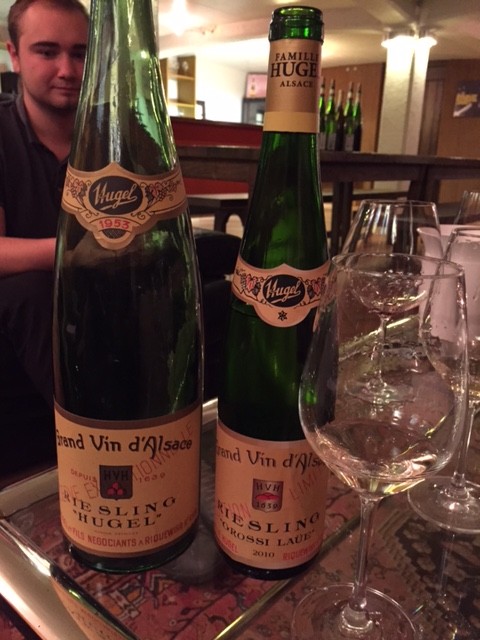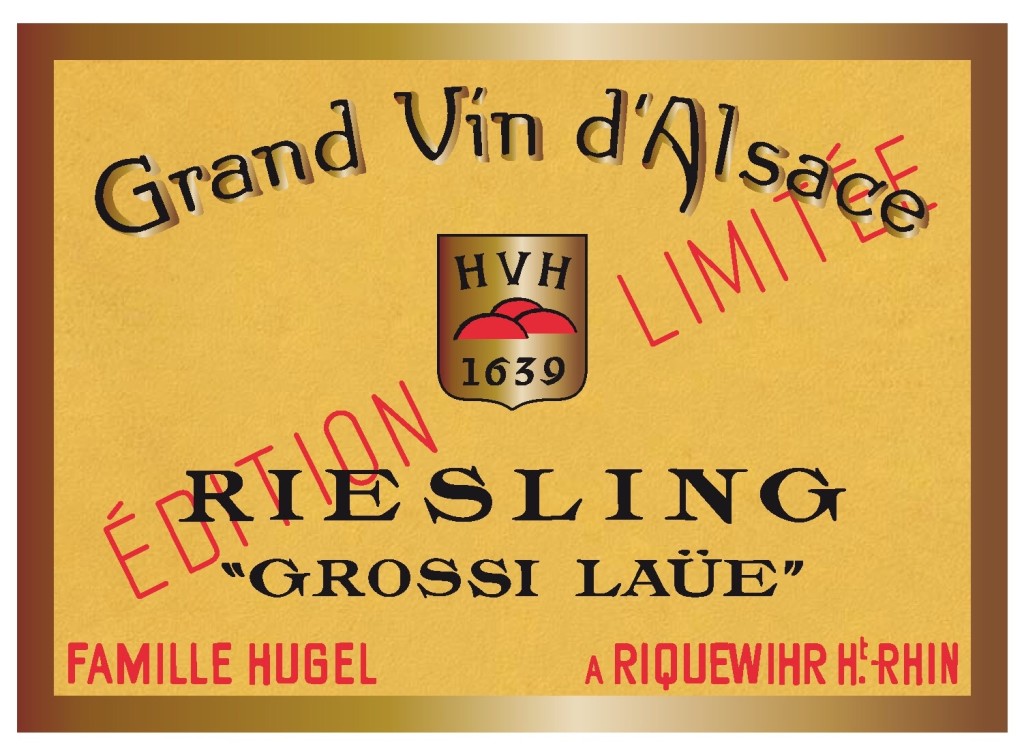No more Jubilee

Hugel’s trend towards terroir, over brand
11 October 2015
By Panos Kakaviatos for wine-chronicles.com
As we have seen with Trimbach, in a previous post from these pages, the historic Alsace estate Hugel also has been critical of the grand cru AOC system established in Alsace in 1975, and revised in the 1980s.
Both estates have long preferred championing their brand wines.
Even if such famous brands as Hugel’s Jubilee and Trimbach’s Cuvee Frederic Emile have been made from vines grown on grand cru terroirs, neither estates ever bothered to mention that fact.
Until recently …
Back in April this year, I reported in decanter.com about a major change in “terroir direction” chez Hugel concerning their Schoelhammer Riesling 2007, named after a specific plot of vines from a grand cru terroir where Hugel owns vines.

Held at the estate for several years before release in 2015: the first terroir named wine from Hugel
Although the Hugel estate has made wines from vineyards it has owned at the grand cru Schoenenbourg (which includes the plot of vines called Schoelhammer), Hugel has long eschewed grand cru designations because of procedural disagreements in designating grand cru sites.
The story I had published back in April this year was that Hugel has, up until now, always sold their wines as brand names, such as their famous Jubilee Riesling, which – until Schoelhammer was bottled – included wine made from the 30 rows of organically farmed Riesling vines that make up the Schoelhammer.
But there is more, dear readers, as I learned on a visit on 5 October this year.
Jubilee itself is no more!
Instead, the estate has changed the name, starting with the 2010 vintage, to Riesling Grossi Laüe. Interestingly, the “new” label – see picture, above (sorry about it not posting correctly, cannot solve this technical glitch!) – resembles very much 1950s era labels used by the domain, but there is a key difference: back in 1953 for example, as you can see in the picture, there was no mention of terroir. Starting in 2010, it is all about terroir as the words Grossi Laüe in Alsatian mean grand terroir.
And that is for all four varietals concerned, not just Riesling.
Why?
As I reported in a more detailed article last year about Alsace’s young generation, more and more consumers and winemakers are stressing terroir, place names and location.
Even if the grand cru system established in Alsace may not have appealed to Hugel or to Trimbach, consumers are appreciating place over name in Alsace – and both estates are reacting.
That two such major producers as Hugel and Trimbach now emphasize terroir over brand name (at least to some extent) is nothing short of extraordinary.
So I was fascinated to finally visit Hugel on 5 October this year, with #winelover founder Luiz Alberto.
I have tasted Hugel wines over the years, and have always enjoyed them, but it was a major gap in my Alsace knowledge to have not ever visited the domain.
And what a fine visit it was, thanks to the frank and informative welcome by Jean Frederic Hugel.
We also appreciated an excellent 2009 Pinot Noir, with Jean Frederic explaining – again – that terroir matters, that one can obtain fine Pinot Noir from Alsace, but that too many vines are planted in the wrong place (and too many winemaker have excessive yields resulting in diluted reds).
For more details on the name changes, stressing more the terroir, here the brochure from Hugel.
Tasting notes. Wines in bold, I liked in particular. When red and bold, even more. When underlined, too, a wine nirvana.
Flight One
- 2013 Hugel et Fils Pinot Blanc Tradition – France, Alsace
This is a tasty Pinot Blanc although just a touch steely with just ripe enough white peach to make it pleasurable. Cropped at almost 65 hectoliters per hectare, no signs of dilution. A lovely drink to start a party. (86 pts.)
- 2012 Hugel et Fils Muscat Tradition – France, Alsace
A delicious Muscat, exuding evident and juicy green melon, grape notes and touches of cumin like spice. Light to medium bodied with a fresh finish. Very enjoyable and a good value. (87 pts.)
Flight Two
- 2012 Hugel et Fils Pinot Noir “Hugel” – France, Alsace
I liked the overall red fruit juicy aspect, even if I got a touch of underripe fruit that prevents me from giving a more enthusiastic score. Medium bodied and medium finish. (87 pts.)
- 2010 Hugel et Fils Pinot Noir “Hugel” – France, Alsace
Here we have – again – a change in name to Grossi Laüe, starting in 2010. Aged in 20% new oak, this Pinot Noir comes from the best plots of the Pflostig vineyard, 400 meters high and with a sloped southerly exposure, made of a granitic sand surface over limestone and clay. I certainly have brighter fruit on the palate here than the preceding wine, even if it has a slightly tart finish. (88 pts.)
- 2009 Hugel et Fils Pinot Noir Les Neveux Jubilee – France, Alsace
Less than 2,000 bottles produced, this 2009 Pinot Noir was excellent. Jean Frederic remarked that it has been placed in blind tastings against Burgundy and shown well. I believe him. The alcohol is close to 15% but not felt – and I am sensitive to high alcohol. The wine was made from old vines planted in 1966, that have been subsequently uprooted, so it really represents a remarkable expression of terroir and old vine Pinot. Savory and deep in cherry flavor, with an earthy aspect that cries Old World. Fairly full bodied but never over bearing, with a long finish. Good stuff! (92 pts.)
Flight Three
- 2008 Hugel et Fils Riesling Jubilee – France, Alsace
To me, not quite as concentrated as the Clos Sainte Hune tasted earlier that day, but a premium brand Riesling indeed, with complex aromatics of kiwi, lime, wet stone and a fine texture on the pure and pristine palate, leading to a long and bright if still somewhat steely (which is normal) finish. With 12% alcohol and three grams of residual sugar, an excellent expression of grand cru Riesling! (93 pts.)
- 2009 Hugel et Fils Riesling Jubilee – France, Alsace
The nose – when compared to the 2008 – seems almost out of focus. But the palate is full of stone fruit, more yellow than white, and very juicy and rich. “I could get drunk on this wine,” remarked Jean Frederic. And why not? It is sheer pleasure, with 13.5% alcohol and nearly 8 grams of residual sugar. (91 pts.)
- 2010 Hugel et Fils Riesling Jubilee – France, Alsace
Like a combination of 2008 and 2009, this 2010 – technically, dear readers, no longer called Jubilee but rather Riesling Grossi Laüe – was harvested at 14% potential alcohol, but there seems to be more relative acidity and thus more zing than in 2009 even if nearly 7 grams of residual sugar. Wet stone dominates here, rather than stone fruit, which is more ripe and white than yellow. I prefer it to 2009, and like its 2008 qualities, although the 2008 may in the longer run prove superior. Full body and long finish. (92 pts.)
- 2007 Hugel et Fils Riesling Schoelhammer – France, Alsace
Was this my overall favorite? Perhaps. Maybe the fact that the estate chose to hold it for several years before release, thus raising the complexity in 2015 did the trick. 2007 is a lovely vintage for Riesling, as it exudes both precision and richness and here we do get both. There is brightness to the pristine expression of fruit, with tension through to the long finish. Bravo! (94 pts.)
Flight Four
- 2000 Hugel et Fils Pinot Gris Vendange Tardive – France, Alsace
Well, well, well. I am not a huge fan of Pinot Gris, except in late harvest expressions and here we have a good example of an excellent Pinot Gris. The nose was beguiling: black tea, very distinct, with juicy yellow apricot and loads of spice with a grilled almond like finish. OK, the 75 grams or so of residual sugar are felt and I do not give it a higher score because of a somewhat medicinal mid palate, but – overall – please pass the foie gras and the chutney. (92 pts.)
- 2009 Hugel et Fils Riesling Sélection de Grains Nobles – France, Alsace
A special SGN that earns a higher score for lovers of these special late harvest Alsace styles. Let me say this, the nose was magnificent: melon, quince, tobacco, papaya, blood orange. Just delicious too on the palate, which came across as crisp and precise given balancing acidity. But yes, there is much sweetness, too – 200 grams of residual sugar – and I could only consume so much of this elixir. A decadent meal unto itself. (91 pts.)
 Wine Chronicles
Wine Chronicles




Share This